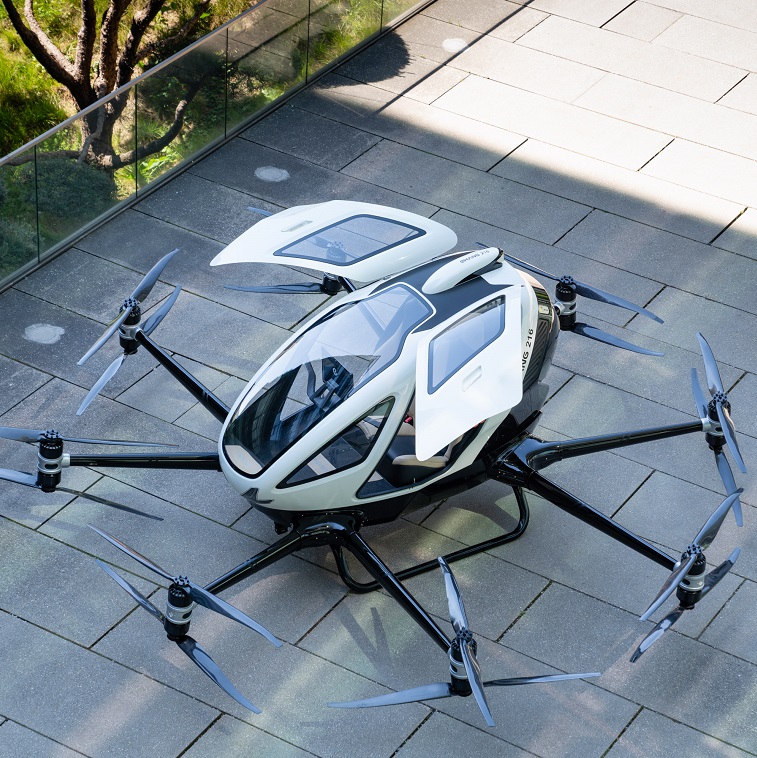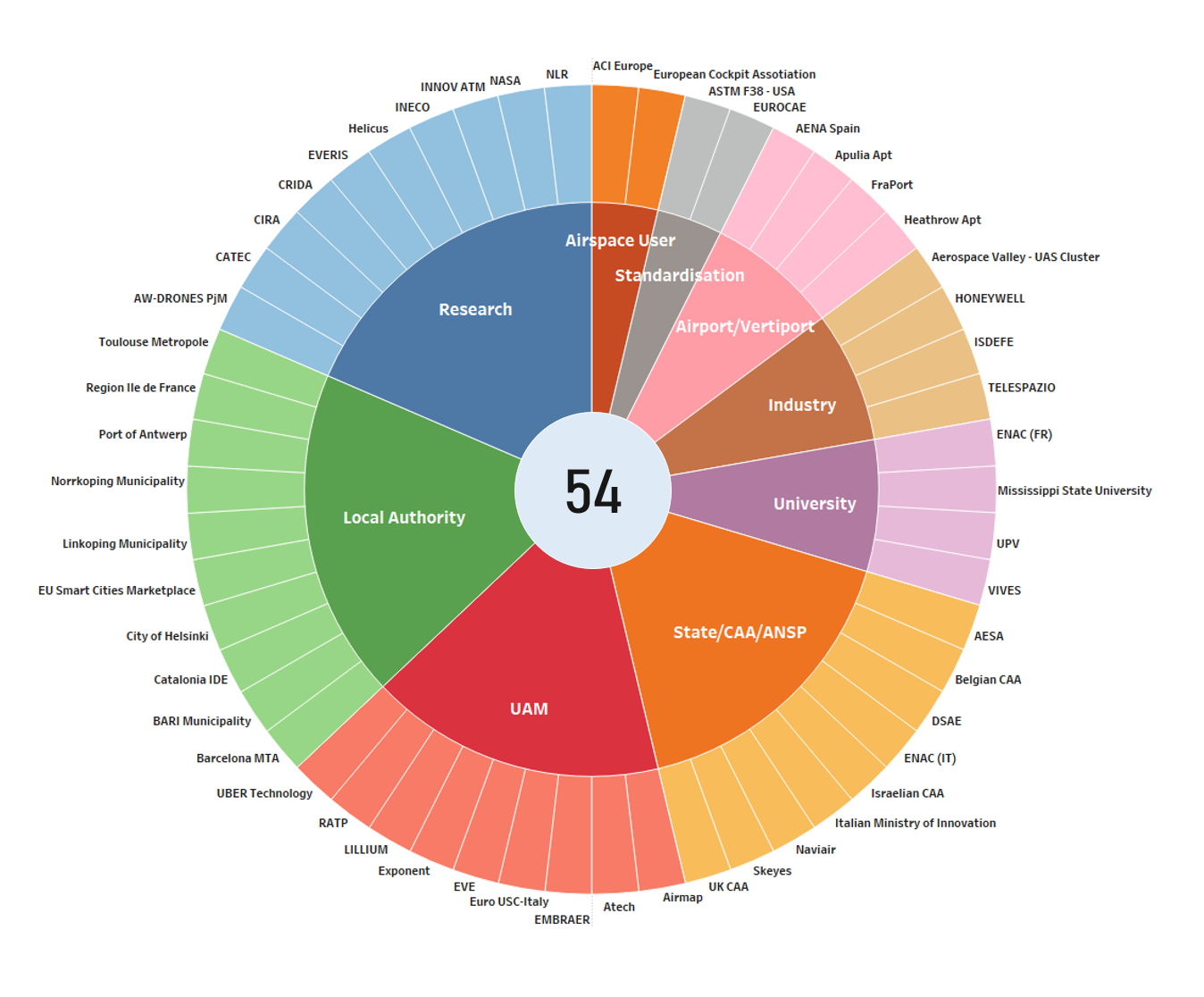CORUS-XUAM is a two-year very large-scale demonstration (VLD) project that will demonstrate how U-space services and solutions could support integrated Urban Air Mobility (UAM) flight operations. These services should allow electric vertical take-off and landing vehicles (eVTOL), unmanned aircraft systems (UAS) and other airspace users (unmanned and manned) to operate safely, securely, sustainably and efficiently in a controlled and fully integrated airspace, without undue impact on operations currently managed by ATM.
The activities will start with updating the U-space Concept of Operations to address the integration of UAM/UAS operations into the airspace, and identifying new U3/U4 services. This will be followed by the preparation and execution of six challenging demonstration campaigns in Belgium, France, Germany/UK, Italy, Spain, and Sweden.
The CORUS-XUAM project is being undertaken by the same consortium as delivered the CORUS U-space Concept of Operations in 2019, again coordinated by the EUROCONTROL Innovation Hub, and has now been extended by the addition of UAM expertise. It now includes partners from the leading innovative research arms of the ATM, UAS and UAM industries. The project is a part of the European Union/SESAR Joint Undertaking Horizon 2020 programme.
Project Highlights

Challenges
U-space and the integration of UAM into low-level airspace will undergo rapid research, innovation and implementation in the short and medium terms. Europe intends to be at the forefront of developing early solutions to support this fast-growing industry. A harmonised approach is essential.
UAM will enable on-demand, highly automated, passenger or cargo-carrying air transport services especially in urban and sub-urban environments, using electric vertical take-off and landing (eVTOL) aircraft together with new concepts, technologies, airspace management constructs/procedures, and regulations. New stakeholders will perform sustainable operations that are interoperable with manned and unmanned aviation as well as with current ATM operations.
Benefits of CORUS-XUAM
The UAM challenges can only be met through an evolutionary development process ensuring the definition of appropriate, advanced and interoperable U-space infrastructure, technologies, traffic management capabilities and new set of advanced services that fit with the expected types of operation and levels of demand.
The project aims to highlight the importance of U-space solutions for integrated operations that require mutual situational awareness of traffic. It will demonstrate integrated operations of both manned and unmanned aircraft employing advanced U-space services and will explore ways to facilitate a proper interface with ATM/ANS (air navigation services), with a particular focus on airport operations.
This will support the European Commission’s vision for the safe, secure, integrated, and efficient handling of drone and UAM traffic operations and will be a key enabler for the growing drone market to generate economic and social benefits

Large-scale Demonstrations
Six very large-scale demonstration (VLD) activities are at the heart of CORUS-XUAM and will validate integrated operations of UAS/UAM and manned aircraft, and advanced forms of interaction through digital data exchange supported by integrated and advanced U-space services in urban, sub-urban, and inter-city scenarios as well as in and near ATM-controlled airspaces and airports. The VLDs will focus on different types of mission such as passenger transport, delivery, emergency response and surveillance.
The VLDs will use different U-space deployment architectures and state-of-the-art technologies. They will consider coordination between ATC and U-space, including interaction with ATCOs and pilots. The VLDs will combine flights by eVTOLs with other traffic, and operations in the CTRs of major airports. Vertiport procedures, separation, and data services will be also demonstrated.
The focus here is the demonstration of the feasibility and benefits of interconnecting airports and city vertiports via UAM for transporting people and goods. The validation will bring together a wide variety of UAM players involved in the target scenario, including Aéroports de Paris (ADP), Paris mobility provider RATP, and Skyports (a vertiport infrastructure developer). Three technical areas will be specifically addressed: a dynamic U-space airspace configuration, trajectory conformity monitoring and the operational guidelines for UAM vertiports operations. For this, the French demonstration will explore a broad range of technologies for communication between drones and U-space traffic management services (such as VHF, SATCOM, 4G and ADS-B). ADS-Broadcast technology is also exploited for its primary purpose as a dependent surveillance information source, to build a picture of traffic information. The validation scenarios include all necessary procedures for the safe integration of vertiports in an urban environment: emergency landing, security and safety processes, boarding/disembarkation of passengers, recharging/ maintenance, and integrated flight and mission planning. This demonstration forms part of the preparation of UAM for 2024 Olympic Games.
The demonstration, led by the Italian Air Navigation Service Provider ENAV jointly with the Italian U-space Service Provider D-Flight and conducted with the support of the Distretto Tecnologico Aerospaziale (DTA), NAIS and the UAM Operator Pipistrel Vertical Solutions, focuses on guidelines for safe depot-to-depot operations between two logistics centres within a suburban area. Flight tests, with involvement of a fast UAM vehicle and other drones for specific operations, will take place at Grottaglie-Taranto civil experimental airport, allowing the involvement of an ATM component and the demonstration of coordination and interoperability between ATM and U-space for the management of UAM traffic. This VLD addresses a UAM-tailored performance framework including safety, access and equity, cyber security and human performance, measured through humans-in-the-loop assessment, such as ATCOs and pilots, during the demonstration.
Project Partners
The EUROCONTROL Innovation Hub in Brétigny, France is coordinating the project, managed by the SESAR Joint Undertaking and funded within the framework of Horizon Europe 2020, which involves 19 partners and 11 related third parties: Groupe Aéroports de Paris, AOPA UK, ASLOGIC, DFS, DLR, Droniq GmbH, DSNA, ENAIRE, ENAV, HEMAV, INDRA, LFV Group, NATS, Pipistrel VS, SkeyDrone, Unifly nv, Universitat Politècnica de Catalunya, Volocopter, M3 Systems, Ehang Holding GmbH, Hologarde, CRIDA, D-FLIGHT, NAIS, DTA, IBG, Linköping University, Citymesh, SABCA.
Preparatory work and flight trials will be performed throughout 2021 and 2022. Insights and recommendations gained from the project will be compiled in a final report on early U-space solutions for UAM deployment in late 2022, and are also expected to be used by regulatory authorities.



